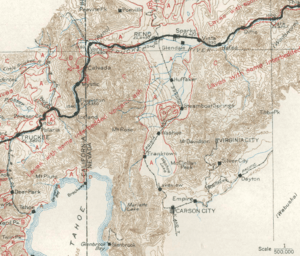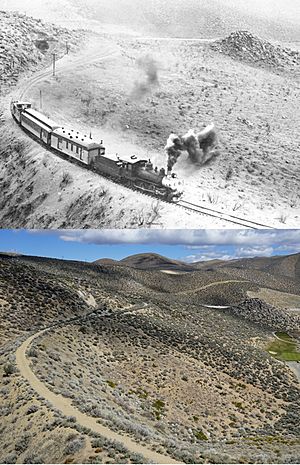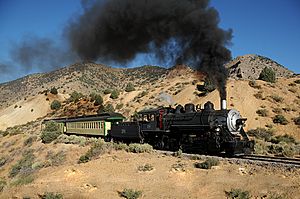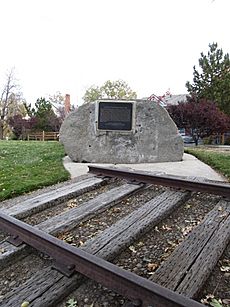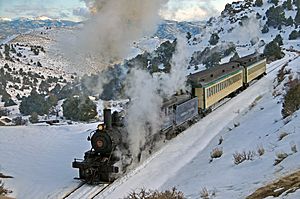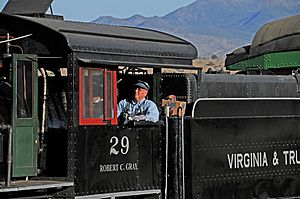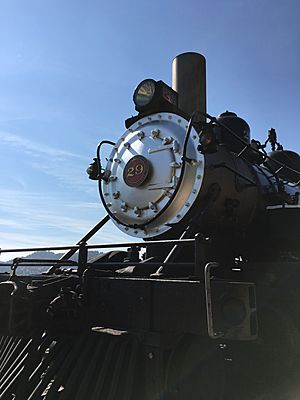Virginia and Truckee Railroad facts for kids
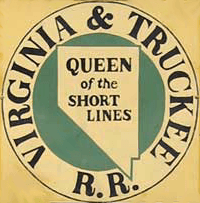 |
|
| Overview | |
|---|---|
| Headquarters | Virginia City, Nevada |
| Reporting mark | VT |
| Locale | Nevada |
| Dates of operation | 1870–1950, 1976-present |
| Technical | |
| Track gauge | 4 ft 8 1⁄2 in (1,435 mm) standard gauge |
| Other | |
| Website | Private Portion Public portion |
| Reference no. | 248 |
The Virginia and Truckee Railroad is a special kind of train line called a heritage railway. It's located in Virginia City, Nevada. This railroad has both private and public parts, and together they stretch about 14 miles long. Long ago, in the 1800s, it was a busy freight railroad. It was built to help the mining towns in northwestern Nevada that were part of the famous Comstock Lode.
At its busiest, the railroad ran from Reno all the way south to Carson City, the state capital. In Carson City, the main line split into two paths. One path went further south to Minden, and the other went east to Virginia City. The very first part of the railroad, from Virginia City to Carson City, was built in 1869. Its main job was to carry ore (rock with valuable metals), lumber, and other supplies for the silver mines.
The original railroad stopped running in 1950 because it wasn't making enough money. Most of the tracks were taken up and sold, along with the trains. But in the 1970s, people became very interested in old railroads again. So, efforts began to rebuild the line. Today, the part between Virginia City and Gold Hill has been rebuilt by private groups. Another part, from Gold Hill to Mound House, was rebuilt with public money and donations.
Contents
The Story of the Railroad
Finding Gold and Silver
Comstock Lode Gold was first found in Nevada in 1850 by travelers heading to the California Gold Rush. These early explorers didn't stay long. But by 1858, more prospectors (people looking for gold) started living permanently near what is now Virginia City. In 1859, gold was found in the hills and canyons outside Virginia City. Along with the gold, they found bluish rocks that were actually silver ore. At first, they didn't realize how valuable the silver was! This discovery became known as the Comstock Lode.
Many mills were built along the Carson River to process the ore from the Comstock Lode. These mills used machines to crush the ore and get the metals out. A powerful bank, the Bank of California, helped fund many of these mines and mills. If owners couldn't pay back their loans, the bank's agent, William Sharon, would take over their properties. Sharon and his partners, Darius Ogden Mills and William Ralston, ended up owning many important mines and mills. They formed the Union Mill & Mining Company to process the ore.
Virginia City grew very fast because of the Comstock Lode. At its peak, over 25,000 people lived there, making it one of the biggest and richest towns in the West. However, it was very expensive to move the ore from the mines to the mills. It also cost a lot to bring wood and supplies back to the mines. Because of these high costs, many mines closed, and only the richest ores were worth processing. Sharon realized that a cheaper way to transport goods would make the mines and mills much more profitable.
Building the Railroad
People had been talking about building a railroad since 1861 to lower costs. Finally, William Sharon decided to build a railroad from Virginia City. It would go through Gold Hill, where the first silver was found, past the mills along the river, and end in Carson City. This route would be 21 miles long and drop 1,575 feet in elevation. It would have so many curves that it would make 17 full circles in just 13.5 miles!
Construction started on February 18, 1869. Workers began building the tracks two miles below Gold Hill. The line needed seven tunnels, each taking months to dig through. They also had to build a huge bridge, called a trestle, 85 feet tall and 500 feet long, over the Crown Point ravine. The first track was laid on September 28, 1869. The first passenger train arrived in Virginia City on January 29, 1870. The railroad quickly became a vital link for people in Carson City and Virginia City. By December 1869, special train cars were even used to bring theatergoers from Carson City to Piper's Opera House in Virginia City.
The first train engine for the V&T was named the Lyon. It was one of three engines bought from H.J. Booth. The other two were the Ormsby and the Storey. The railroad also ordered two more engines, the Virginia and the Carson, from Baldwin Locomotive Works. These first five engines were named after Nevada counties or towns. The Lyon was the first engine to pull a work train into Virginia City on January 28, 1870, completing the first part of the line. Regular passenger service began on February 1, 1870.
On November 12, 1869, V&T Engine No. 2 pulled the first car that earned money for the company. It was a flat car loaded with lumber for the Crown Point Company, going from Carson City to Gold Hill. This was a big moment for the railroad. On November 18, 1869, Engine No. 1 hauled the railroad's first train of ore from the Yellow Jacket mine. By December 21, regular trains were running between Gold Hill and Carson City. They carried wood and lumber up the hill and ore back down to the mills.
The railroad cost $1,750,000 to build, not including the trains or buildings. At its busiest, during the "Big Bonanza" (a time of great wealth from mining), the V&T ran 30 to 45 trains every day between Carson City, Virginia City, and Gold Hill. It was mostly a freight railroad. In 1876 and 1877, at its peak, it had 22 engines and 361 freight cars. They carried over 400,000 tons of freight each month! There were only 10 passenger cars, showing how important freight was.
Growing and Prospering
In late 1871, the railroad started building an extension to Reno. This would connect the V&T line with the Central Pacific Railroad. This meant trains could travel all the way from Virginia City to San Francisco! The first train to run the entire route, from Virginia City to Reno, happened on August 24, 1872. It was pulled by the newest engine at the time, No. 11, named the Reno. This completed the Virginia and Truckee Railroad. By 1875, the railroad was making over $100,000 profit each month.
In 1880, the V&T built a smaller, three-foot wide railroad called the Carson & Colorado. This "narrow gauge" railroad ran from Mound House, near Carson City, south into California. The idea was to reach new mining areas near the Colorado River, but this didn't work out. By 1891, those mining claims were mostly forgotten. The "slim princess," as it was called, was not very profitable for the V&T. So, in 1900, it was sold to the Southern Pacific Railroad.
Soon after, silver was found in Tonopah, Nevada. The Carson & Colorado railroad became very busy for the Southern Pacific. Wagons would travel for miles across the desert to reach the narrow-gauge line. Then, the ore would be carried back to the V&T at Mound House. But there was a problem: the ore had to be unloaded by hand from the narrow-gauge cars and reloaded onto the wider "standard gauge" V&T cars. This caused big delays. To fix this, the Southern Pacific changed the narrow-gauge C&C to standard gauge in 1904. This allowed their trains to run directly through Mound House to Tonopah.
In 1904, the company changed its name to the Virginia and Truckee Railway. In 1906, the V&T built a short branch line to Minden, about 26 miles south of Carson City. This line helped transport farm products and cattle, bringing in more freight business. To handle this, the V&T bought three new powerful engines from Baldwin.
The Railroad's Slowdown
The Virginia and Truckee's decline started around 1924. That was the first year the railroad didn't make a profit. Mining income had dropped a lot. Also, fewer people were riding the trains because more and more people were using cars. New highways, like US 395 and US 50, ran right next to the V&T lines.
By 1933, Ogden Livingston Mills, whose grandfather helped start the railroad, owned it. He personally paid for the railroad's losses to honor his family's history. But after Mills died in 1937, the railroad faced serious financial trouble. In 1938, they started planning to shut down. The Virginia City branch was already taken apart that year. When the railroad finally closed in 1950, it only had three working engines. The last train, pulled by engine No. 27, ran on May 31, 1950.
Lucius Beebe, a famous railroad historian, moved to Virginia City. With photographer Charles Clegg, he helped bring new life and interest to the town and the old railroad by writing books about it.
Bringing the Line Back to Life
In 1972, Robert C. Gray, who had ridden the last train to Virginia City in 1938, wanted to rebuild the V&T as a tourist attraction. After getting permission, work began to rebuild the line. They worked to reopen Tunnel #4, which was finally ready in the late 1980s. They also started on Tunnel #3, but a large rock fell and blocked it. So, they built a detour track around the tunnel instead.
On January 3, 2006, officials held a "silver spike" ceremony in Carson City. This celebrated finishing two miles of track near Gold Hill. This was part of a bigger plan to restore the V&T's main line from Virginia City to Carson City. Important leaders like Harry Reid and Lorraine Hunt helped get millions of dollars in funding for the project. The first part of the extension allowed trains to go beyond Gold Hill to American Flats.
It's estimated that finishing the line from Gold Hill to Carson City will cost over $55 million. The goal was to have the line fully open again by 2012, but as of 2021, trains only go as far as Eastgate Station. In June 2008, engine No. 29 started running again after a big repair.
The Nevada Commission for the Reconstruction of the V&T Railway rebuilt the line from Gold Hill to Carson City. The first train on this rebuilt section ran on August 14, 2009, after 68 years! The next day, the line opened to the public.
Historic Trains and Equipment

The Virginia and Truckee's old trains and equipment appeared in many Western movies. This is because the railroad kept using older, classic trains long after other lines had switched to newer ones. Many of these historic pieces have been fixed up and are now on display in museums across the country. You can see original V&T cars and engines at the Nevada State Railroad Museum in Carson City, the Comstock History Center in Virginia City, the California State Railroad Museum in Sacramento, and the Railroad Museum of Pennsylvania in Strasburg.
There's even a smaller, working replica (copy) of the V&T engine Reno that has been running on the Washington Park and Zoo Railway since 1959. In 2018, the Nevada State Railroad Museum swapped engines: No. 18 "Dayton" went to Carson City, and No. 27 went to the Comstock Historic Center. In 2020, a replica of V&T #1 was sent to Carson City to be completed at the Nevada State Railroad Museum.
| No. | Name | Type | Builder | Built | Remarks |
|---|---|---|---|---|---|
|
|
Lyon (Replica) |
|
H.J. Booth |
|
A replica is being built at the Nevada State Railroad Museum. |
|
|
Reno |
|
Baldwin |
|
The V&T got this engine in August 2021. It's being restored. It used to be on display at Old Tucson Studios. |
|
|
Genoa |
|
Baldwin |
|
Owned by the California State Railroad Museum, on loan to the Nevada State Railroad Museum. |
|
|
Empire |
|
Baldwin |
|
On display at the California State Railroad Museum. |
|
|
Dayton |
|
CP's Sacramento shops |
|
Owned by the Nevada State Railroad Museum, soon to be on loan to the California State Railroad Museum. |
|
|
Tahoe |
|
Baldwin |
|
On display at the Railroad Museum of Pennsylvania. |
|
|
J.W.Bowker |
|
Baldwin |
|
Owned by the California State Railroad Museum, on loan to the Nevada State Railroad Museum. |
|
|
Inyo |
|
Baldwin |
|
It can run and is on display at the Nevada State Railroad Museum. |
|
|
Unnamed |
|
Baldwin |
|
It can run and is at the Nevada State Railroad Museum. |
|
|
Unnamed |
|
Baldwin |
|
On display at the Comstock History Center in Virginia City, Nevada. |
Other Historic Recognitions
- The Virginia and Truckee Railroad Shops are listed on the National Register of Historic Places.
- The Virginia and Truckee Railroad Depot - Carson City is also on the National Register of Historic Places.
- The Virginia and Truckee Railway Motor Car 22 is a National Historic Landmark.
How the Railroad Operates Today
The Virginia and Truckee Railroad uses the special name "Queen of the Short Lines." The V&T Railroad runs up to seven trains a day from Memorial Day until the end of October. Many of these trains are pulled by steam engine No. 29, a 2-8-0 Consolidation, or by a diesel engine.
The railroad's first season of operation was in 1976. They used a leased engine (No. 28), two open cars, and a caboose (No. 10) from the original V&T. These were too expensive to keep, so they were returned. Engine No. 28 and Caboose No. 10 are now at the Nevada State Railroad Museum.
For the 1977 season, the railroad needed an engine. They used a small Porter 0-4-0T engine (No. 3) that was too small and smoky. Around this time, they got three old cars from the Western Pacific. One boxcar was made into an open-air car (No. 55), and a caboose was changed for passengers (No. 50). Another boxcar (No. 54) was made into a "tunnel car" to help reopen Tunnel #4. It was also used for passengers.
In 1977, Bob Gray bought a Baldwin 2-8-0 engine (No. 680) at an auction. It was in good shape and was soon renumbered to 29. In 1984, the railroad got an old Southern Pacific 0-6-0 engine (No. 1251). It's too tall for Tunnel #4, so it's unlikely to be used. The 1980s also saw the addition of another engine, No. 8, a 1907 Baldwin 2-6-2. It was used along with No. 29.
In 1991, engines #29 and #8 pulled a "double-header" train together, starting regular service to Gold Hill. By 2001, both engines needed repairs. So, for the first time, the V&T used a diesel engine. They leased a GE 44-ton switcher (No. 3) for the 2002 season. In 2003, they got a more permanent diesel, a GE 80-ton switcher (No. 1694), which was named D-1. It became the main engine while the steam engines were being fixed. No. 29 returned to service in 2008.
Engine No. 8 didn't run again until 2012 due to a disagreement about its ownership. In 2005, the Commission got a 1914 Baldwin 2-8-2 engine (No. 18) from the McCloud Railway. This engine is owned by the commission but operated by the Grays. In May 2010, an ALCO S-4 Diesel engine (D-2) was acquired, but it doesn't run well due to a lack of parts. On July 24, 2010, steam engine No. 18 started regular service. It had just been in the movie Water for Elephants.
In December 2010, an old rail car from the CB&Q was brought to Virginia City. It was meant to run in 2011, but its wheels were too small. So, it's now used as a woodshop. In mid-2013, the V&T got its original 1870 passenger depot back. All ticket sales and gift shop operations moved there from an old coach car.
In May 2013, the railroad acquired a GE 44-ton switcher engine (D-3) and three passenger cars from the Yuma Valley Railway. D-3 started passenger service in June 2016. It was repainted in the railroad's colors in July 2017.
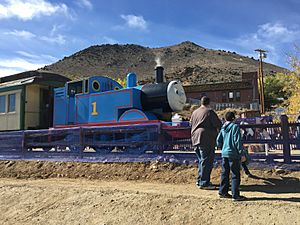
The railroad hosted its first Day Out with Thomas event on October 24, 2015. In November 2016, the railroad acquired an EMD SW1200 diesel engine (D-4). In 2018, another 80-tonner (No. 1605) was acquired. It's used for spare parts for D-1 and D-3.
In 2020, a second caboose (No. 52) was acquired. It started being used on daily trains to Gold Hill in August 2021. In 2021, engine No. 29 and some cars were taken to Oklahoma to appear in the film Killers of the Flower Moon. For the movie, No. 29 was painted to look like an old Atchison, Topeka and Santa Fe Railway engine.
On August 25, 2021, the railroad got back engine No. 11 Reno from Old Tucson Studios. The plan is to fix it up so it can run again. If it does, it will be the first original V&T engine to run on the rebuilt line. Three days later, on August 28, 2021, trains from Eastgate Siding started running again after being stopped in 2020 due to the COVID-19 pandemic. This also marked the return of engine No. 18 to service.
In February 2022, the V&T acquired three more pieces of equipment from the Fillmore and Western Railway: a Pullman car, an ALCO S-6 diesel engine (No. 1059), and the body of a refrigerated car. Engine No. 1059 was acquired to replace D-2. In May 2022, the railroad acquired a Baldwin 2-8-2 engine (No. 100) from the Oregon Coast Scenic Railroad. It's currently stored in Gold Hill, waiting to be restored.
Trains and Cars You Can See Today
Here are some of the trains and cars currently owned by the new V&T railroad:
Steam Engines
- No. 8: This Baldwin 2-6-2 engine was built in 1907. It's stored in Mound House and can run, but there are no plans to use it on the V&T because it's owned by another group.
- No. 11: The V&T No. 11, a 4-4-0 Baldwin engine built in 1872. It was the first engine to run between Reno and Carson City and was called "Brass Betsy." It was sold in 1945 and later damaged by fire. The revived V&T got it in 2021. It's currently on display and planned to be restored to run again.
- No. 18: This Baldwin 2-8-2 engine was built in 1914. It's leased to the V&T Railroad and can run. It returned to service in 2021 after a big inspection.
- No. 29: This Baldwin 2-8-0 engine was built in 1916. The V&T got it in 1977 and restored it from 2001-2008. It's named "Robert C. Gray" and can run.
- No. 100: This Baldwin 2-8-2 engine was built in 1926. The V&T got it in May 2022. It's currently stored in Gold Hill and needs restoration.
- No. 1251: This Southern Pacific 0-6-0 engine was built in 1919. It arrived in Virginia City in 1984. It's not working and is partly taken apart. It's too tall for Tunnel #4, so it's unlikely to be restored. Its tender (the car that carries water and fuel) is used to refill other steam engines.
Diesel Engines
- No. D-1: This General Electric 80-ton switcher was built in 1953. It arrived in 2003 and runs daily.
- No. D-2: This ALCO S-4 was built in 1951. It arrived in May 2010 but doesn't work because parts for its engine are hard to find.
- No. D-3: This GE 44-ton switcher was built in 1943. It arrived in May 2013 and runs daily. It was repainted in V&T colors in 2017.
- No. D-4: This EMD SW1200 was built in 1957. It was acquired in November 2016 and can run.
- No. 1059: This ALCO S-6 was built in 1956. It was acquired in February 2022 and can run.
- No. 1605: This GE 80-ton switcher was acquired in 2018. It doesn't work and is used for spare parts for D-1 and D-3.
Motor Cars
- No. M-1: This car was built in 1926. It arrived in December 2010 but doesn't run because its wheels are too small. It's used as a woodshop.
Passenger Cars
- 1st No. 25: This combination car was built in 1888. It was used as the Virginia City Ticket Office from 1976 to 2013.
- 2nd No. 25: This caboose was acquired in the late 2000s. It's in working condition and used on Gold Hill trains.
- No. 50: This bay-window caboose was built in 1916. It started service in 1977 and is used on Gold Hill trains.
- No. 51: This bay-window caboose was destroyed in a fire in 2003.
- No. 52: This bay-window caboose was built in 1979. It was acquired in 2020 and is used on Gold Hill trains.
- No. 54: This was an old boxcar converted into a "tunnel car" that can carry passengers. It's used on Gold Hill trains.
- No. 55: This was an old boxcar converted into an open-air car. It was built in 1916 and is used on Gold Hill trains.
- No. 100: This parlor car was built in 1907 and is named "Ardelle Mae." It's used for special events.
- No. 101: This coach car was built in 1914 and named "Gold Hill." It's used on Carson City trains.
- No. 102: This coach car was built in 1914 and named "Silver City." It's used on Carson City trains.
- No. 103: This coach car was built in 1917 and named "Carson City." It's used on Carson City trains.
- The V&T also owns several other old passenger cars that are currently in poor condition in the Virginia City yard.
The Railroad in Movies and Myths
The McCloud No. 18 steam engine, a 2-8-2 Mikado, was used in the movie Water for Elephants. It returned to the V&T after filming and had its first public run on July 24, 2010.
There's a popular story that the Crown Point Trestle, a huge bridge on the V&T line, was so amazing that it's shown on the Nevada State Seal. However, this is a myth! The state seal was created before the trestle was built, and it actually shows a different type of bridge, called a viaduct, not a trestle.
See also
 In Spanish: Virginia and Truckee Railroad para niños
In Spanish: Virginia and Truckee Railroad para niños


